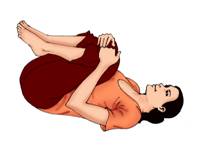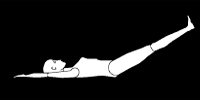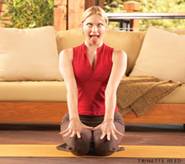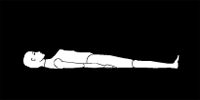INTRODUCTION
Today Sinus is the most common disorder all over the world. Sinusitis is the name for a condition in which the lining of your sinuses becomes inflamed. Sinusitis can be explained as a condition in which a person experiences severe and acute inflammation in the air-filled cavities present inside the human skull. Sinusitis may attack people of any age and sex.

YOGA AND SINUSITIS

YOGA POSES FOR SINUSITIS
Palm Tree Pose
This pose harnesses the powers of mental concentration, while allowing you to calm the mind. It develops balance and stability, and strengthens the legs and feet, also increasing flexibility in the hips and knees. The tree pose is a balance pose incorporating three lines of energy, emitting from the centre outwards.
Mountain Yoga Pose
The Mountain Pose is one of the most important poses in yoga. It is the start and finish point of all standing poses. When standing in mountain pose, the mind is quiet and the body strong and still, like a mountain. This is a pose you can practice in your daily life, practicing to stand correctly will have a profound influence on your physical and mental well being.
Head-to-Knee PoseHead-to-Knee Pose helps to balance the blood sugar level. It improves the flexibility of the sciatic nerves, ankle, knees and hip joints; improves digestion; enhances the proper functioning of the kidneys; and expands the solar plexus. The Stretching Pose relieves chronic diarrhea by improving the circulation of the bowels. It also increases circulation to the liver and spleen and improves digestion. It increases the flexibility of the trapezius, deltoid, erector femoris, and bicep muscles, sciatic nerves, tendons, hip joints, and the last five vertebrate of the spine.
Camel Pose
The name, like many translations of Sanskrit names, gives a false sense of how this pose works. Ustrasana is a beautiful backbend, and when performed correctly it can help to open up the chest and the thoracic spine - and we can't forget the deep stretch in the hip flexors (psoas) (this is the area at the very top of your thigh). It is always flexed when you're sitting at your desk and driving in your car, and yet we rarely remember to stretch this area of muscles.
Triangle Pose
Cobra Pose is a heart-opening back bend. The pose challenges the shoulders, the chest, and lengthens the spine. The basic movement of the cobra is to arch the spine backward.
Downward Facing Dog
The Downward Facing Dog Pose builds up strength in the upper arms and rejuvenates the entire body. Though it is an exercise in itself, this pose is often used in between other exercises.
Lion Pose
The Sanskrit word simha which literally means "the powerful one" is the word for "lion." This therefore is known as the lion posture, and one performing it can be said to resemble a roaring lion about to attack. Yoga Lion Pose is a great exercise for your face muscles and neck. It also heals sore throat symptom.
Cobra Pose
This is a basic yoga posture. It is very easy to do especially if your back is not too stiff and rigid. The root of this pose is bhujanga, which is Sanskrit for "serpent". Although you'll find this posture in many yoga styles, practitioners of Kundalini Yoga believe that this is one of many poses that awakens the coiled energy at the base of the spine.
YOGA ASANAS FOR SINUSITIS
PAVANMUKTA ASANA

It activates the pancreas and other organs of the abdomen and also relieves wind trouble; acidity etc.It loosens the hip-joints and activates the abdominal muscle and intestines and ultimately cures the constipation, and corrects the malfunctioning of stomach. It is easy asana and people of any age can do it.
Steps
• Lift one knee up towards the chest.
• Put the same side hand on the ankle and other hand on knee.
• Pull the knee towards the chest without any pull on the ankle.
• Without disturbing the posture relax all muscles and continue normal breathing and stay in that position for 6 to 8 sec.
• While releasing slowly move hands to normal position, leg to original position.
• Repeat this with other leg pressed against chest/ stomach.
UTTHANPADA ASANA

In Utthan Pada Asana, both the legs are lifted upwards. This asana gives excessive strain to the spine. In case of any spinal injury this asana can be practiced by lifting one leg at a time. Strengthens the spinal code and corrects disorders of the back. Reduces paunch and removes constipation, indigestion and gas trouble.
Steps
• Lie on the floor with your body straight. Heels should be together. Look towards the ceiling.
• Slowly inhale and take in as much as air you can.
• Holding your breathe lift both the legs up about 10 inches high from the floor. Legs should be held together straight and toes stretch forward. Retain for about 5 seconds.
• Exhale slowly and begin lowering the legs simultaneously.
• Complete exhaling by the time your legs are brought back to the floor..
SIMHASANA

The simha-asana benefits parts of the body that most other asanas do not: the face, jaw, mouth, throat and tongue. Those who experience tightness or discomfort in the jaws such as teeth grinding, clenched jaws, a misaligned bite, etc. will benefit from both the jaw and tongue stretching of the simha-asana. This asana is also known to help prevent or cure sore throats.
Steps
• Sit up on the knees with the heels of the feet pressed against the buttocks and the calves of the legs flat on the floor.
• Place the balls of the hands on the knees, straighten the arms and keep the back erect and the head straight (not tilted forward, back, to the left or the right).
• Inhale while leaning forward slightly, stretching the mouth the jaws as wide as possible, extend the tongue out and downward as much as possible, fix your gaze either at the tip of the nose or between the eyebrows and stretch the fingers straight out from the knees.
• Hold the posture for the duration of the inhaled breath then exhale, relaxing the forward stretch, dropping the fingers to the knees and closing the mouth and eyes.
DHANURASANA

In Salamba Sirsasana, the head supports the whole body. As the entire body benefits from this pose, this asana is generally known as Sarvangasana. In the classical pose, the hands support the back. This is called Salamba Sarvangasana.
Steps
• Lie on your stomach with your arms stretched on both sides. Place your right or left cheek on the floor. Bend the knees, bringing the feet up. Bring the heels close to the buttock area. Reach back to hold the ankles with your hands. The knees and the ankles should be closer to one another.
• Inhale as much air as you can. Straighten up your neck and head. Holding the breath and keeping the arms straight, arch the entire body upwards. Lift the head, chest and thighs off the floor. Remain in this position for 5 to 6 seconds.
• Exhale and return to the floor smoothly. Keep holding the ankles while you return to the first position. Put the cheek back on the floor and breath normally.
• Leave the ankles and let the legs gradually return to the floor. Bring the arms and hands to the floor on both sides and relax for 6 to 8 seconds. You have completed one round of bow posture.
SHAVASANA

Shava asana derives its name from "Shava" is a sanskrit word meaning "dead body". In this asana, the state of body takes the posture of a dead person. Therefore this asana is also known as "corpse pose". This asana is called so because every limb becomes relaxed while doing this asana.
Steps
• Lie down on your back on a yoga mat/ carpet.
• Keep both the legs a little apart about one to one and a half feet from each other.
• Keep both the hands a little away from the side of the body.
• Now let the left toe point towards the left and right toe towards the right.
• Head may be kept straight or may be inclined towards the left or right.
• Whole body should be in a straight line and relaxed.
• Close your eyes gently.
• Imagine that the entire body is relaxed. This way each and every organ of the body will get relaxed. Concentrate your mind on your body parts from toe to your head and feel your body is getting lighter.
• While in this asana carry out normal rhythmic breathing.
BHASTRIKA_PRANAYAMA

With the practice of Bhastrika, swelling of the throat is corrected, appetite is kindled and the cough is removed. Diseases of the nose and chest like asthma, tuberculosis etc. are also corrected. If no other means to warm the body is available, it can be heated with the help of this Pranayama.Pores of Sushumna nerve are opened by Bhastrika.
Steps
• Sit in Padmasana, Siddhasana or Vajrasana stretch your head, neck and back. Put your hands on the laps.
• Inhale and exhale rapidly your or five times like a blower. Similarily contract and expand the lungs. A peculiar rusting sound will be produced during the practice of this Pranayama.
• At the completion of one round (Avartana) the performer must inhale breath as deeply as possible and retain it as long as possible. Ultimately exhale as much breath as possible.
• Thus a round (Avartana) of Bhastrika completes.
• After resting a while, perform another round of this Pranayama. During the first week do two rounds only. From second week onwards, do three to four rounds of Bhastrika pranayama.
ASTROLOGY
Yoga is the primary level which consists of bodily exercises to build a ground for Meditation. The word yoga had been derived from the Sanskrit word yuj which means to join to unite to balance or to integrate. Yoga is a system of exercises for the mental and physical well being. It combines stylized poses with deep meditation and breathing. According to astrological reports for yoga asanas the above mentioned asanas are said to be effective for those who come under the following zodiac sign.
• PISCES